Cat Behavior, Cats/Cat Facts, Feline Health
How To Discipline A Cat
how do i discipline my cat

The Real Response To This Inquiry Is:
You Don’t Discipline A Cat – You Train A Cat
There are a couple of really important principles to understand aboutAnalyze the Situation
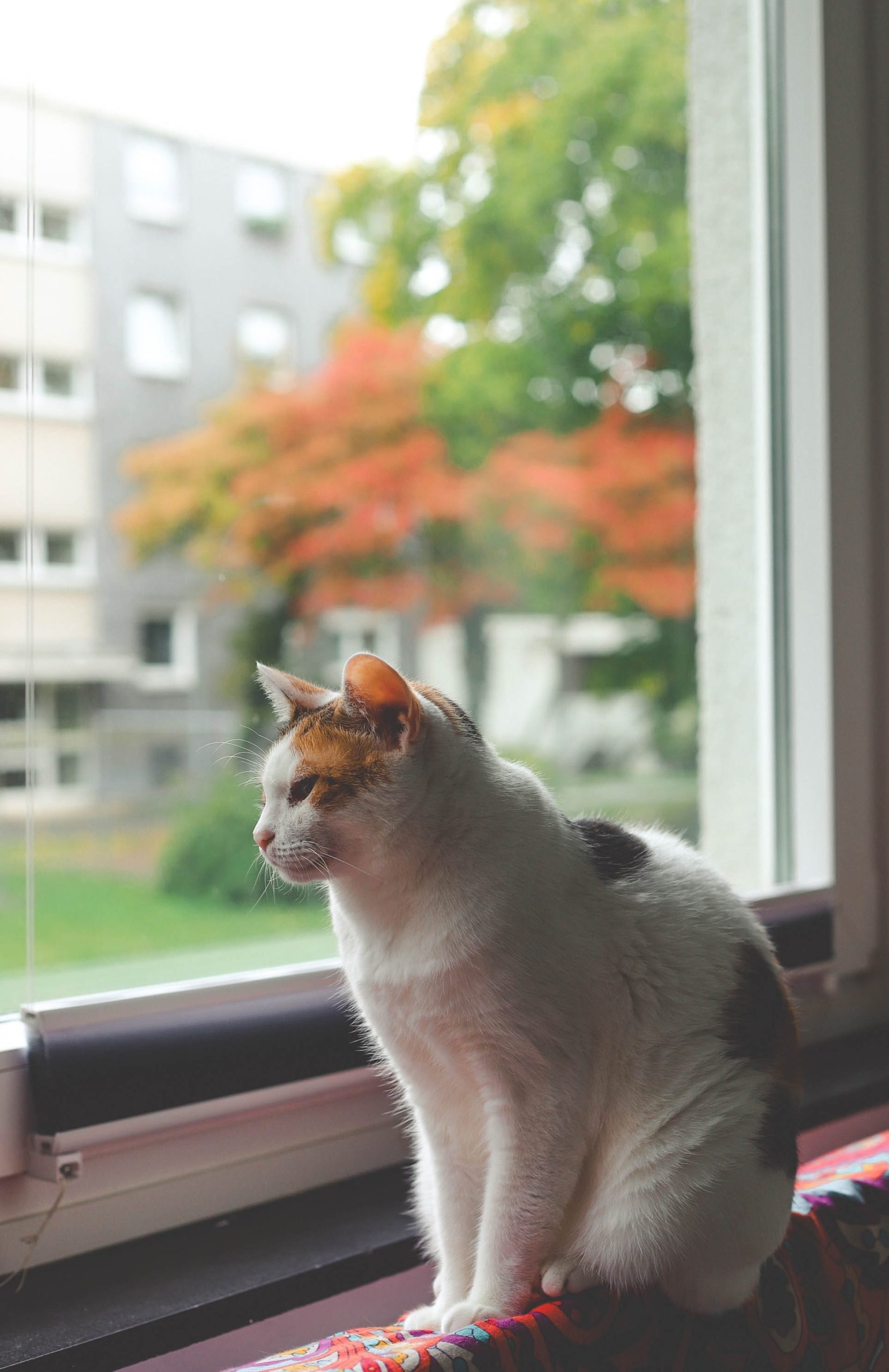
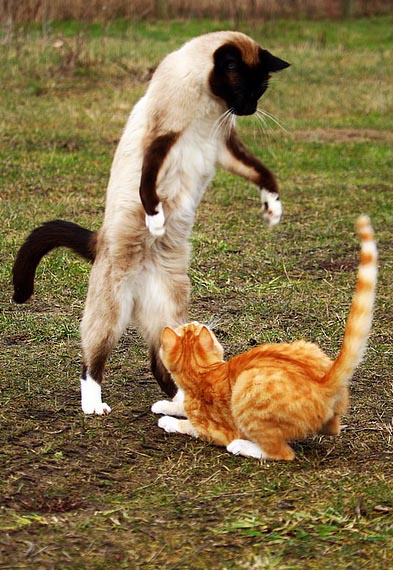
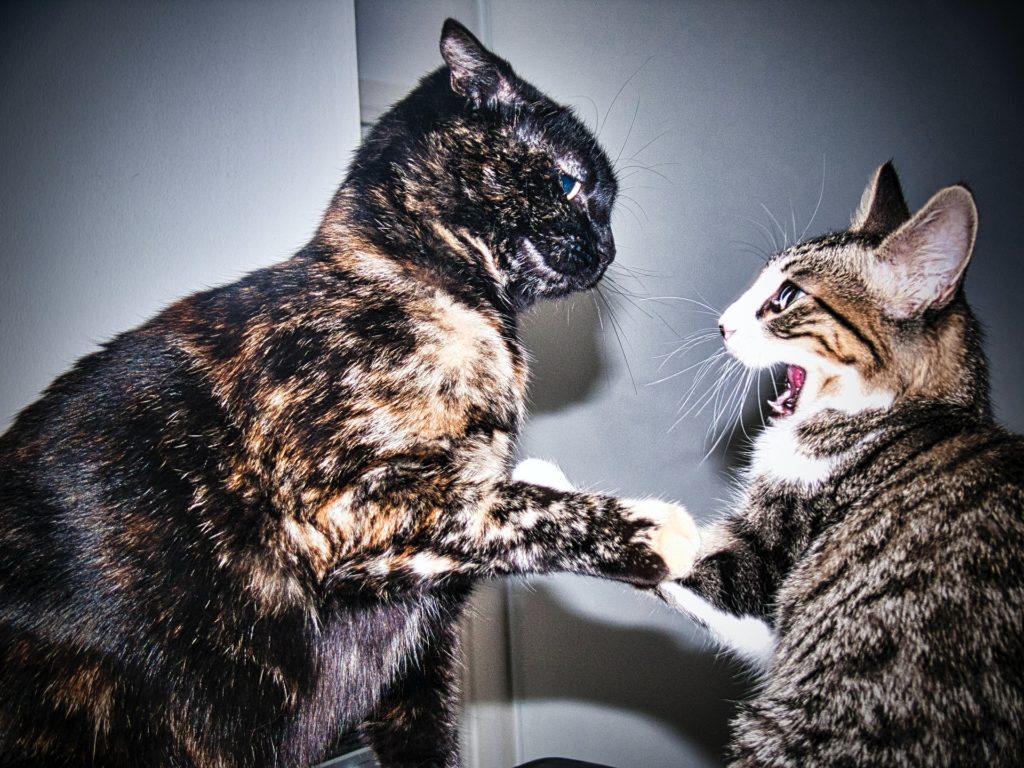
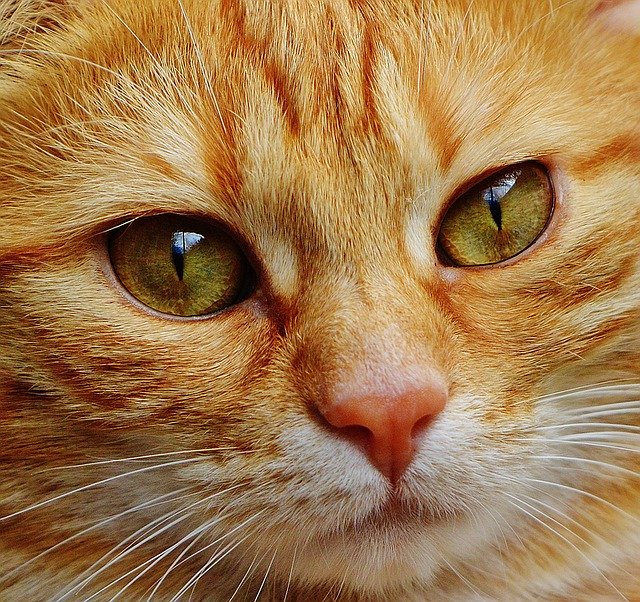
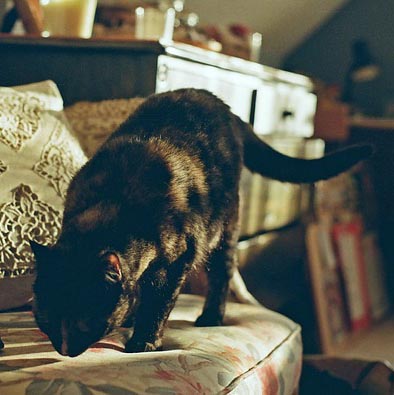
Your Cats’ Territory
A frequent cause of stress which can lead to unwanted behavior is when something has gone wrong (from your cat’s perspective) in the environment. For example another cat or other animal prowling around outside your home may go unnoticed by you but not by your cat and that can be highly stressful. It’s your cats territory and unless he has access outside, he can do nothing about the fact that his territory is being violated – a fairly intolerable situation. If you cat does have access outside, an invader will also be highly stressful but at least in this instance he has the potential to deal with it. If it comes down to actual combat even a weaker cat is at an advantage on his own turf. In any case he can mark and remark his territory and that will help relieve the stress.Cats Don’t Like Their Environment Changed
Changes within the household can also be stressful. Is there a new member of the family or has someone left? Has the house gone through a rearrangement? Often if we ask what has changed in our cat’s orbit we can find the cause of his problem. Cats are meticulous. They establish their relationships with considerable cognizance. They need to know what they are dealing with and what to expect from those entities with whom they are interacting. That includes the environment itself. They don’t like surprises because surprises are a threat. Changes in the environment represent the presence of forces unknown to the cat, and anything unknown is potentially dangerous.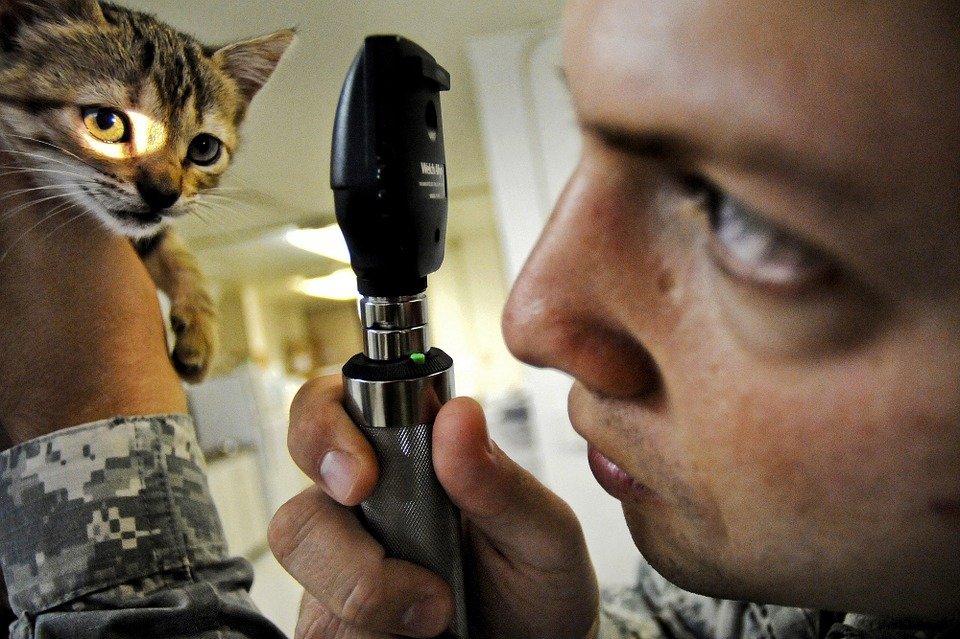
Aggression Toward People
According to the book, Feline Behavioral Health and Welfare by Ilona Rodan and Sarah Heath the most common behavior issue for which cat owners seek assistance is aggression toward humans. These veterinarians say their are four basic causes of this sort of behavior.
- Defensive response from feeling threatened
- Displaced play/preditory/attention seeking
- Frustration
- Disease or illness
Feeling Threatened
Of these the most common, they say, is aggression from feeling threatened. Cats are small animals and it doesn’t take a lot for them to feel threatened, particularly if they have not been socialized in the first eight weeks by positive interaction with humans. (Note that socialization continues after eight weeks and positive interaction will always be important.) Most cat’s prefer to flee in response to threat but this isn’t always possible and aggression can be the result, the consequences painful. If your cat is new to you and this is what you are experiencing when you approach or try to interact with your cats there are some do’s and don’ts to observe. Remember, he is already afraid and doesn’t trust you to not hurt him. That is a trust you must earn.
and aggression can be the result, the consequences painful. If your cat is new to you and this is what you are experiencing when you approach or try to interact with your cats there are some do’s and don’ts to observe. Remember, he is already afraid and doesn’t trust you to not hurt him. That is a trust you must earn.

We Can’t Demand Affection
It is never a good idea, simply because it can’t succeed, to force yourself upon a mistrusting or frightened cat or kitten. Going after him and trying to get hold of him will only frighten him more and make him more aggressive – his way of dealing with a threat he can’t escape. Instead, allow him to come to you. Unless actually feral, completely unsocialized or previously abused, he likely will, in time. An older cat that has been socialized but has gone through traumatic experience may take time, and even a long time, but if no negative action or neglect is brought upon him he will probably come around. Just allow it to be on his terms and in his time.
If you got your cat from a breeder he most likely has been socialized. If you got him from a shelter you may not know his background so caution and care is advised. Cats are sensitive creatures and care and respect are always a good idea in dealing with them. Do listen to what the people working at the shelter have to say about the cat you are acquiring. They are normally very tuned into the animals under their care and can give you very useful insights into your new cat.
neglect is brought upon him he will probably come around. Just allow it to be on his terms and in his time.
If you got your cat from a breeder he most likely has been socialized. If you got him from a shelter you may not know his background so caution and care is advised. Cats are sensitive creatures and care and respect are always a good idea in dealing with them. Do listen to what the people working at the shelter have to say about the cat you are acquiring. They are normally very tuned into the animals under their care and can give you very useful insights into your new cat.
Displaced play/preditory/attention seeking
If your cat or kitten leaps out at you, grabbing you by the ankles, biting or scratching you or when you’re playing, bites your fingers or hand this is often the result of play techniques you initiated earlier in his life and which he is carrying forward and further, inappropriately. Hiding your feet or hands under a cover and moving or wiggling them gets an amusing response from the kitten as his hunting instincts kick in and he tries to catch the hidden prey. When he grows up however those behaviors and reactions may take on a more serious, and seriously painful expression. The best way to prevent this from happening is to, when still a kitten, play with him using toys, not your hands or feet. There seem to be about as many kinds of toys for cats as there for humans, and in a wide range of prices so your choices of which toys to get for your kitten and cat are countless. But if that behavior has already been created and is now become a problem there are specific do’s and do not’s. The first, big do not is don’t punish your cat by squirting him, yelling at him or throwing anything at him. That will increase his anxiety and confusion, and likely his aggression. Drs, Rodan and Heath also recommend against reacting by screeching, jumping away or demonstrating any other strong response as it is in part your reaction the cat is after. He wants to get a rise out of you, so to speak. What he is after is interaction and what he is doing is an attempt at that which he learned, in part from you. So you need to initiate a different form of interaction.
It may be a little difficult to do this and you may want to wear some extra clothing when entering a scenerio where his attack is likely to happen but to tame this behavior of him, don’t react at all. Pause, speak gently to him and gently urge him away. If he is biting you, be as still as you can, speak gently and gently and slowly pull away. Make him understand that what he is doing is meaningless and having no effect. This will baffle him at first and will do a lot to tamp down his enthusiasm for performing those tricks – they don’t work. When the situation is calm wait a while, then get out a toy he likes, such as a wand type toy and play with him. In other words you need to wean him away from his misplaced aggressive behavior and encourage other kinds of play.
away or demonstrating any other strong response as it is in part your reaction the cat is after. He wants to get a rise out of you, so to speak. What he is after is interaction and what he is doing is an attempt at that which he learned, in part from you. So you need to initiate a different form of interaction.
It may be a little difficult to do this and you may want to wear some extra clothing when entering a scenerio where his attack is likely to happen but to tame this behavior of him, don’t react at all. Pause, speak gently to him and gently urge him away. If he is biting you, be as still as you can, speak gently and gently and slowly pull away. Make him understand that what he is doing is meaningless and having no effect. This will baffle him at first and will do a lot to tamp down his enthusiasm for performing those tricks – they don’t work. When the situation is calm wait a while, then get out a toy he likes, such as a wand type toy and play with him. In other words you need to wean him away from his misplaced aggressive behavior and encourage other kinds of play.
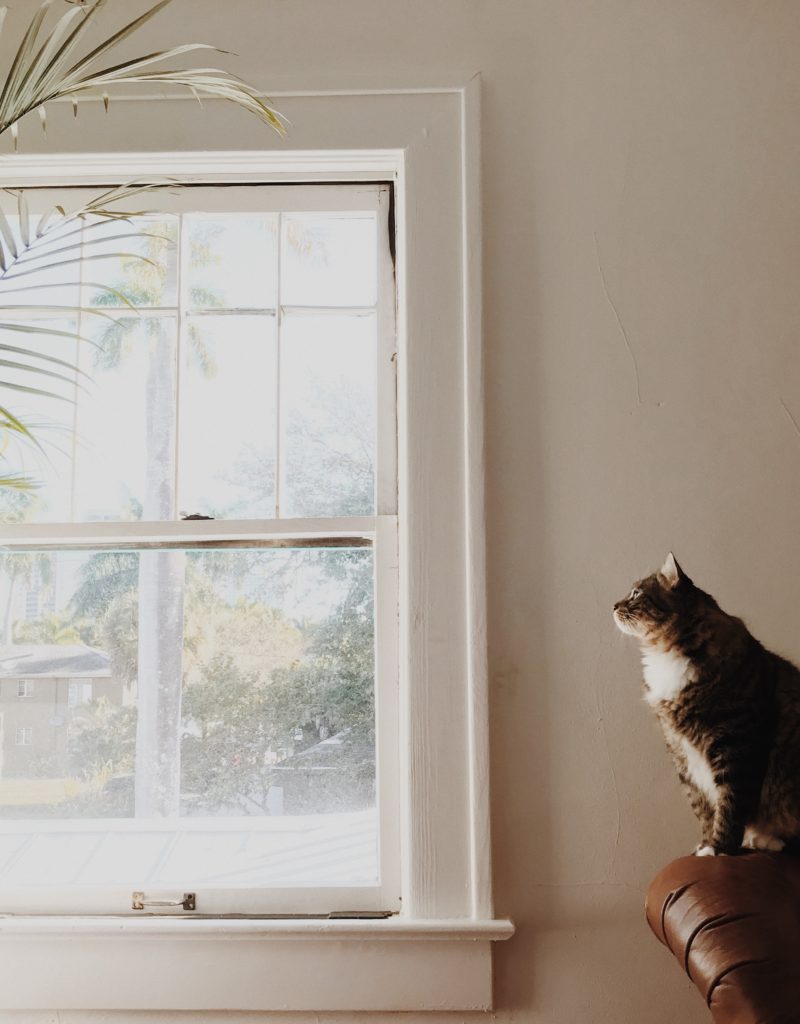
Frustration
Many things can cause your cat to be frustrated, from an untidy litter box to a badly placed one to simply not having enough micro environments which permit your cat to be a cat. We previously mentioned the situation of another cat or other animal outside of which your cat is aware and you may not be. If you find him looking out the window and he seems a bit agitated or downright riled up, go have a look. If there is another cat you’ll have to find how to deal with it – shoo him away, close the curtains, or some other action. If you do manage to make your cat unaware of a trespasser and his aggressive behavior stops you’ll know you have found the issue. A litter box or food or water source near loud or frequently used appliances or high traffic areas will also cause unease and can lead to unwanted behavior so look at all that. Remember, cats are very sensitive (one of the reasons we are so drawn to them), and they can’t tell us what is bothering them. The books, Catify To Satisfy and Catification, by Jackson Galaxy’s (the Cat From Hell guy) and Kate Benjamin of Hauspanther tell of the sorts of environments cats crave and how beneficial creating these sorts of environments can be. This is a very important concept and crucial to the health and happiness of our cats. Cats need to be cats and being a cat means being able to use the natural given abilities in environments that naturally and of necessity exercise those abilities. Climbing, jumping, running, hunting, scratching, dashing and hiding are all part of a cat’s repertoire so to what extent do our homes not only permit but encourage such activities? For Mr. Galaxy and Ms. Benjamin, cats seem to be somewhere near if not at the center of their lives and they present a wide range and some very extreme examples of home modifications to make your cats environment more of what a cat craves. Not every home can accommodate and not every cat needs all of what they present, but there are plenty of things we can do to ‘catify’ our cats environment. (Place a cardboard box somewhere he will find and can use it and you will have begun the process because it seems there never was a cat who could resist climbing into a cardboard box.)
present, but there are plenty of things we can do to ‘catify’ our cats environment. (Place a cardboard box somewhere he will find and can use it and you will have begun the process because it seems there never was a cat who could resist climbing into a cardboard box.)
Other Unwanted Behaviors
that occur as a natural consequence of your cat being a cat and behind which there is no psychological or health issue are numerous, such as jumping onto counters, scratching the furniture or waking you up in the early hours to play, be fed or watered. Of course there are others and they can all be quite annoying but they often are just the result of your cat’s inherent nature. They don’t indicate a problem but if you want to make them stop, you can, all by using the same principle; understand your cat’s nature and give him what he needs. This is where the previously mentioned concept ‘Catify’ comes in. Here we offer some basic guidlines for dealing with specific issues but urge you to read Catification, and or Catify to Satisfy.Cats & Counters
Cats like to jump and climb. Cats use those talents in nature both in the pursuit of food and to escape danger. And they seem to like counters in particular but there are good reasons for not allowing your cats on them. Often the stove is built into a counter and the chance of your cat landing on a hot burner is very real. You may also feel it is not hygienic for your cat to walk, sit and lie on your food preparation surfaces. But how to keep him off? There are a variety of solutions offered from various sources for keeping your cat off the counter: Put two sided tape on the edge of the counter, or tape tinfoil to the edge, both of which cats don’t like and are deterrents. Drawbacks to those solutions are fairly obvious – you have to endure the presence of the tape and tinfoil too and replacing them is a bit of a bother as well as, in the case of tinfoil, wasteful. There is a motion sensor sprayer which emits a harmless but disagreeable spray you put on the counter. When your cat jumps up, the sprayer activates and is said to repel him. There are other sprays and numerous devices, such as the ht-pet Snappy Trainer which when stepped on, flips up into the air making a snapping noise and is supposed to frighten your cat away. Which it probably will do until he comes back to investigate, which he probably will do and discovers this odd looking paddle-thing which now lies lifeless on the counter. Often cats jump onto counters because they want the sink faucet turned on. They crave moving water (which is why cat fountains are so successful). As an alternative, if you have the space, give them a small table with a fountain and they are very likely to jump on that rather than your counter.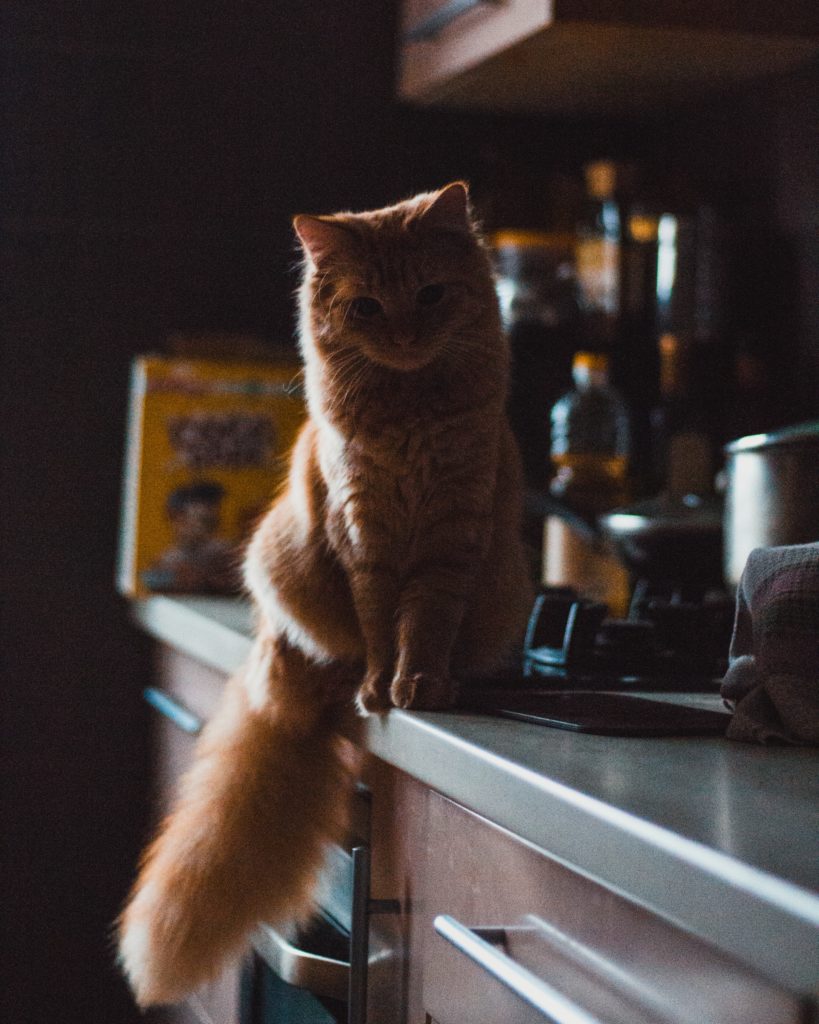

Let Them Climb, Let Them Jump
Generally, we all like to do what we’re good at. So too with cats and they excel at climbing and jumping. So give them the resources for doing this that keeps them off surfaces and furniture you don’t want them on. Again, look into Catify and see all the many ways you can implement something that your cats will love in your home and which will probably resolve a number of behavioral issues.
Cats like to go up. Your crown molding, door tops, refrigerator, bookshelves, backs of chairs and anywhere else they can either climb or jump to. If you want to have a say in where they go, you can put up some shelves or construct other devices which offer the adventure of climbing, jumping, lounging or about anything else cats like to do.
home and which will probably resolve a number of behavioral issues.
Cats like to go up. Your crown molding, door tops, refrigerator, bookshelves, backs of chairs and anywhere else they can either climb or jump to. If you want to have a say in where they go, you can put up some shelves or construct other devices which offer the adventure of climbing, jumping, lounging or about anything else cats like to do.
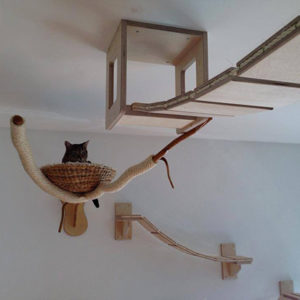 There are some extraordinarily elaborate constructions, far more so than what you see here to the left, as well as more simple ones. The point is, cats will jump onto your furniture or climb onto you counters and all the other things they do being cats but it has nothing to do with your furniture or the attempt to displease you. It is because these are the activities cats naturally perform and need to perform daily.
So it makes perfect sense to proactively provide them with some devices or environmental arrangements that allow and encourage these activities.
There are some extraordinarily elaborate constructions, far more so than what you see here to the left, as well as more simple ones. The point is, cats will jump onto your furniture or climb onto you counters and all the other things they do being cats but it has nothing to do with your furniture or the attempt to displease you. It is because these are the activities cats naturally perform and need to perform daily.
So it makes perfect sense to proactively provide them with some devices or environmental arrangements that allow and encourage these activities.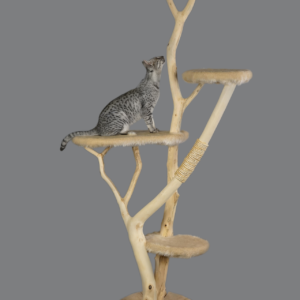 It may be hard to picture any of these devices in your home but if you want to have happy, healthy, no problem cats, it behooves you to find a place and a way to include some form or another of the sorts of devices they need. Your cats will be happy, you’ll be happy. And the entertainment value isn’t just for your cats. You will love seeing them perform their natural talents in an environment designed for just that. You can find a variety of them here.
It may be hard to picture any of these devices in your home but if you want to have happy, healthy, no problem cats, it behooves you to find a place and a way to include some form or another of the sorts of devices they need. Your cats will be happy, you’ll be happy. And the entertainment value isn’t just for your cats. You will love seeing them perform their natural talents in an environment designed for just that. You can find a variety of them here.
Cat Scratching & The Demolition Of Furniture
About everyone who has a cat has bewailed the shredding of their sofa or armchair arms. Long threads wave out from everywhere and you wonder what will the guests think. Bad cat. Nope. Cat. Scratching fulfills at least three feline needs. They need to stretch, they are driven to leave their scent and they need to groom their nails and because they don’t have a better option they choose our furniture. So what do we do about this? We give them a better option. Scratching trees. Cats have scent glands on the pads of their feet and they feel an instinctive urge to press them against objects, and people. Whether or not they know they are leaving their scent we leave to wiser folks to say, but that they are, and feel the impulse to do it is certain. Cats also love to stretch – some of the original yoga poses and practices were derived from observing cats. And, they need to groom their nails. They need to pull off the outer sheaf and give a tone-up to one of the most vital weapons in their arsenal.
That they are ruining our furniture is a side issue and to them, not an issue at all. Probably no cat on the planet would vote against a sisal rope cat tree or cat scratcher so long at it is tall enough for the cat to reach up and stretch and stable enough not to wobble.
Sisal rope will last pretty much forever and gives just the right amount of resistance and tooth. Cats love it. The scratching pole or tree being tall enough makes stretching, which cats are so good at and so like to do, a natural use of the thing and so long as it is weighted enough and doesn’t topple or begin to, you cat will feel entirely at ease. But where in your house should it go?
impulse to do it is certain. Cats also love to stretch – some of the original yoga poses and practices were derived from observing cats. And, they need to groom their nails. They need to pull off the outer sheaf and give a tone-up to one of the most vital weapons in their arsenal.
That they are ruining our furniture is a side issue and to them, not an issue at all. Probably no cat on the planet would vote against a sisal rope cat tree or cat scratcher so long at it is tall enough for the cat to reach up and stretch and stable enough not to wobble.
Sisal rope will last pretty much forever and gives just the right amount of resistance and tooth. Cats love it. The scratching pole or tree being tall enough makes stretching, which cats are so good at and so like to do, a natural use of the thing and so long as it is weighted enough and doesn’t topple or begin to, you cat will feel entirely at ease. But where in your house should it go?
Where To Place a Cat Tree or Cat Scratcher Depends
on the issues you are facing. The long answer is; several places. If you are having a problem the short answer is very near there the problem scratching is taking place, like next to your sofa arm. There should be others around the house too – the idea being that this need of your cat to scratch gets satisfied elsewhere so your couch doesn’t become a focus or destination. Quite truly, you cat does not try to irritate you. He simply needs to scratch and nothing will stop that from happening. Where it happens is up to you.3 AM And Your Cat Wants You Up
to be fed, watered, or for play? Doesn’t really matter. It isn’t acceptable. To function well in all you do, including caring for your cat, you need to be rested and strong and that won’t be the possible if you are wakened from a sound sleep at the wrong time, night after night. So what do you do? First, don’t respond. Don’t get up when this first occurs. As cute as his behavior may be as he gently gently paws your face and as hard as it may seem, turn away, pull the covers over your head and go to sleep. If he is not screaming hell and death it is simply your cat living in a different time zone from you and wanting something he Wants but doesn’t Need. Whatever it is, give it to him in the morning – the real morning, after 6AM or whenever you normally get up. But there is more you can do besides ignoring him. If he wants play, make sure he has some interactive, engaging toys not in your bedroom. There are lots of them and most are not expensive. If it is water he wants, he should never be deprived of that. Make sure he has a fountain that is specially made for him. He’ll never over-drink and will be deeply gratified to have fresh flowing water from a ceramic cat fountain. As to food, cats vary enormously here. Some cats can have an open bowl of food and never get fat and some will always be fat no matter how much you (think you) are feeding them The key here is activity. If your cat stays active with interactive toys that engage his motor skills he will, oddly enough, desire less food. Eating is often just something to do that feels good. The same for us. Give your cat things to do that are fun and engaging and you may well find him balancing his own diet without your help. But start early with this. It’s hard to teach a fat cat to be slim.He Just Wants To Play
So he bops you on the nose or the cheek ever so gently and says, ‘Hey, get up. Let’s play’. And it is so cute, so endearing. It is also 3 AM and you have work in the morning. How cute is it really? Something must be done. The question becomes, what is he missing? Food – we covered that and water too. Play? Make sure he has interactive toys, and there a lots of them. Some of the most engaging toys are the simplest, such as the wire with two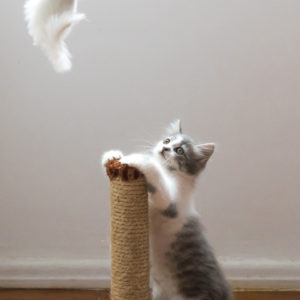 pieces of wood on the at end and a handle on your end. It just dangles and bobs and fascinates your cat. You can anchor your end under a heavy book on an elevated surface and leave the wire dangling. Your cat will come back to it again and again.
But What if Your Cat Just Wants Affection? Then you’re left to what your relationship is all about. And in fact, this is also how your relationship grows. You don’t need advice on this. Maybe you take him in your arms, into bed and give
pieces of wood on the at end and a handle on your end. It just dangles and bobs and fascinates your cat. You can anchor your end under a heavy book on an elevated surface and leave the wire dangling. Your cat will come back to it again and again.
But What if Your Cat Just Wants Affection? Then you’re left to what your relationship is all about. And in fact, this is also how your relationship grows. You don’t need advice on this. Maybe you take him in your arms, into bed and give  him the love he needs. Quiet him, caress him and if that is what he is there for, he will be content. So will you be. Maybe you give him some mumbled encouraging words and push him down onto the bed. He’ll get the message. And both of you will be not just content but happy because you have a love and an enduring bond and a communication that takes into consideration both of your wants and needs and after all is that not what a relationship is? And this creates something for you both that can’t be measured or weighed but which is priceless.
him the love he needs. Quiet him, caress him and if that is what he is there for, he will be content. So will you be. Maybe you give him some mumbled encouraging words and push him down onto the bed. He’ll get the message. And both of you will be not just content but happy because you have a love and an enduring bond and a communication that takes into consideration both of your wants and needs and after all is that not what a relationship is? And this creates something for you both that can’t be measured or weighed but which is priceless.
Sign-up for our Newsletter
It's free, fun, informative and doesn't come too often. You may also receive occasional notices of special sales or news from ThirstyCats.
By submitting this form, you are consenting to receive marketing emails from us . You can revoke your consent to receive emails at any time by using the SafeUnsubscribe® link, found at the bottom of every email.

This is the sweetest, most accurate, article on (not disciplining) a cat, that I have ever read! I hope many people will read and incorporate the advice here into how they care for their cats.
When I first rescued my ‘littlest’ (and wildest) cat, he regularly scratched my sofa – to the point that I feared for it’s complete destruction. I placed a fantastic Cat scratcher right up against one side of the sofa. Each time he went to scratch I would say (in the gentlest voice “No No Saint.. Right here buddy!” while gently lifting him (and pulling his claws out of my couch lol) over to the cat scratcher. Then, I would praise his scratching as he showed off wildly scratching his post.
Now whenever he starts to scratch the couch, as soon as I say, “No No buddy” – Of his own accord, he seems to think to himself, “Oh that’s right, the scratcher!” and he moves himself right over to it. He is proud of the fact that he understands THAT is the place to scratch 🙂